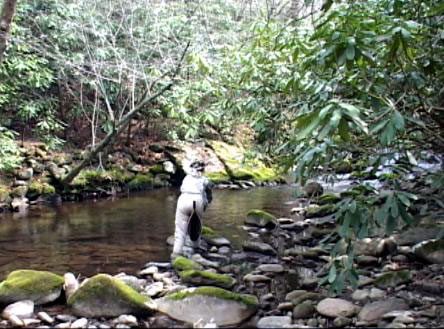If you like fishing a small stream that is away from the crowds of the larger communities and most tourists, try Cosby Creek. It is an easy and delightful little stream to fish.
Cosby Creek is located in a fairly remote section on the north end of the park near a community where moonshine was more plentiful than the water in Crosby Creek, at one time. Now, it is one of the fastest growing areas surrounding the park. It’s a great place to take youngsters who are learning to fish. The trout are fairly easy to catch.
Cosby Creek may have some traffic and a crowded campground at times, but it’s not usually crowded from a fishing standpoint. Its headwaters want be crowded for certain. Rock Creek, Inadu, Toms and Crying Creek are all very small brook trout streams in the headwaters.
All but some of the lower areas of the stream are tightly enclosed with tree limbs. It is fairly easy to get around in the lower part of the stream below the campground. Much of it can be fished from the banks, although keeping your fly out of the trees and bushes isn’t exactly easy.
Cosby Creek has some beautiful short runs and a few riffles. Its pools are usually full of wild trout. Since the trout are all wild, streambred trout, a certain amount of caution should be used. They are easy to spook. Good presentations are usually needed to fool them.
Cosby Creek requires small stream tactics anywhere you fish it. The lower part of this stream is a quick and easy stream to fish. The upper headwaters require some hiking to get to. The lower section has lots of small rainbows but there have been a few larger ones caught there also. The stream is stocked just outside of the park. A road follows the lower section up to the Cosby Campground. You can stop and fish just about anywhere there, within sight of the road.
As just mentioned, you can hike into the headwaters but you can also catch plenty of brook trout starting at the campground and fishing upstream. You don’t have to make an extended hike to catch them. The farther you hike into the headwater, the better the fishing usually is. It gets far less pressure.
These small to tiny headwater streams typically have a short plunge and a small pool. The gradients are usually quite steep. There are few areas where the water flows only moderately. Most all of it’s fast water. The brook trout can be found in just about every little pool. They usually don’t hold and feed in the fast water of the plunges or in the white water. Most often they are positioned in the slower moving water at the ends of the pools. It just requires sneaking up on them and making a soft presentation that doesn’t spook them. It also requires keeping your flies out of the trees. Casts are normally only a few feet. It usually takes all types of short, creative casts to get the fly in the right spot. Stay very low and sneak up to each area large enough to hold a brook trout.
The lower section along the road is quite different. Cosby Creek is one of the small brook trout streams that you can reach from a road. There are not that many in Great Smoky Mountains National Park. Brook trout start showing up as low as just below the Cosby Campground. Most of the trout below the campground will be rainbows. Fish upstream in the short riffles and runs. There is enough room to cast in many areas but some areas are very tight and enclosed with tree limbs. Short, upstream casts are all that are required. High sticking nymphs in the fast water are also usually effective but most of the time the trout will respond to dry flies.
James Marsh has made his living fishing since 1980 through hosting and producing the first ever national syndicated weekly TV series on saltwater fishing for five years; hosting and producing forty-six instructional saltwater fishing videos more of which have been sold on saltwater fishing than anyone’s in the world; and for the past twenty-two years hosting and producing nineteen instructional videos on fly fishing and founding the Perfect Fly Company.
